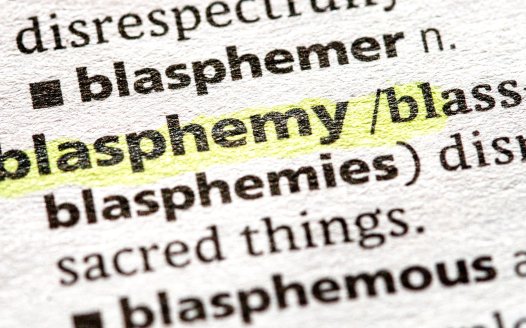The advertising regulator is pandering to religious offence-taking
Posted: Thu, 4th Apr 2019 by Chris Sloggett
As a regulator issues patronising advice to advertisers in the run-up to Easter, Chris Sloggett takes a look at its guidance on religious offence – and finds a deep and damaging aversion to freedom of expression.
If you didn't know that Easter "holds religious significance, particularly for those of the Christian faith", never fear. Last week the Advertising Standards Authority, which regulates advertising in the UK, took the chance to highlight this little-known fact on a new web page, 'Avoiding causing religious offence during Easter'.
The page tells marketers to "keep in mind that whilst Easter ads can be fun and entertaining, they must also be responsible". They should "tread carefully and bear in mind that just because something might be considered funny by some – it will nevertheless be problematic if it offends a particular group".
It is "important to exercise caution" when referring to religion, "particularly when it comes to respecting people's faith and beliefs". Advertisers should "consider research into the likelihood of causing serious or widespread offence to followers of the faiths concerned". Humour "can sometimes help to reduce the likelihood of causing serious or widespread offence", but "the line when it comes to religion can often be very thin".
Adverts which portray religion in a positive light are fine; those which mock religion are not. Advertisers are "able to use religious language and imagery in their advertising, provided it is not mocking or disrespectful". An advert which put Jesus in a rabbit costume was apparently fine, because it "was intended to highlight the commercialisation of Easter which had prevailed over the traditional meaning". But an email advertising a sex toy which featured the phrase "res-erection" was out of bounds. (Disappointingly, a link attached to the word "res-erection" just takes you to the ASA's ruling on that case.)
It might be easy to dismiss this as a patronising bit of virtue-signalling to Christians, particularly as advertisers are hardly likely to change their plans substantially three weeks before Easter. But as a public body charged with policing the boundaries of acceptable expression, the ASA has a significant responsibility not to shut down adverts without good reason, or encourage advertisers to self-censor unnecessarily. So it is worth taking a closer look at its broader stance on religious offence. And doing so reveals that it has a deeply-embedded aversion to freedom of expression.
In its latest comprehensive guidance on religious offence, issued in 2016, the ASA outlines two forms of offence ("rational offence" and "emotional offence") – before noting that "those with a strong religious belief" are twice as likely as "those with no religious belief" to feel either. At this point a regulator which respected the equal rights of the religious and the non-religious would surely indicate that heightened feelings of offence do not give anyone an extra right to act as a censor. The ASA does not do this.
The document that follows consistently places a premium on the feelings of the religious. Advertisers are told they should "only" use ecclesiastical language "in a way that does not ridicule religion". "Tolerance" does not extend to the "disrespectful" use of "Christian images". It's unacceptable to depict "men or women of the clergy" in an "unsuitable or denigratory" way.
There may be "some components of religion that simply cannot be used". Even if marketers intend "to go no further than poking gentle fun", they are told that "neither the message nor the words and visuals" should be "dismissive of the religion or its followers". Followers of non-Christian religions are infantilised, as references to their faiths "may be more likely to cause serious or widespread offence".
The guidance treats religion in the same way as a group of immutable characteristics. It cites the Committee of Advertising Practice's code: "Particular care must be taken to avoid causing offence on the grounds of race, religion, gender, sexual orientation, disability or age." This fails to distinguish between adverts which may make egregious generalisations or statements about groups of people (including religious groups) and those which lampoon religious ideas.
Perhaps the ASA will stand up to the particularly uptight attitudes to sex which religion tends to promote? No. Advertisers are told to "be mindful that those with strong religious beliefs are generally more sensitive to the use of swearing and sexual innuendo". Communications which make sexual jokes which might offend Christians are out of bounds or "likely to be problematic". So don't display "lead me into temptation" across a male model's groin, portray "nuns in a sexualised manner" or say "holy mother of Christ" while alluding to promiscuity.
Then comes an especially egregious passage on 'sex and religion':
"Overtly sexualised images can cause offence to some religious groups; for example, the ASA received complaints about female nudity on buses and bus stops in strictly orthodox Jewish areas. Marketers should be mindful of how they portray sex, nudity and women if marketing communications, especially posters, are likely to be seen by people with strong religious belief."
So the ASA accepts religious groups' double standards on the portrayal of men and women. Amid all the apologia nobody seems to have spotted the line "how they portray sex, nudity and women".
It also accepts the absurd – and inherently theocratic – idea that certain public territory has a religious character. (It also does this again later on, calling on marketers to "take into account whether the marketing communication is likely to appear in particularly sensitive locations" – such as "close to places of worship or outside religious schools".) Suffice be it to say that a bus stop is not a synagogue, and advertisers can hardly be expected to plan for every instance where someone nearby might be offended by something they've created.
Religious groups are not just allowed to monopolise public space; they are also given a veto on the grounds of timing. Marketers are told to bear in mind "whether a marketing communication's appearance coincides with any significant religious festivals".
The blasphemy law may have been abolished in England and Wales in 2008. But this is an all-too-familiar attempt to uphold de facto blasphemy codes under the guise of civility and politeness. Advertisers' commercial freedom and the freedom of unoffended members of the public are just the latest casualties of undue deference to religious sensitivities.
And the ASA put out similar messages in online advice on religious offence in July 2018. (Do advertisers really need updating on this subject this often?) Religion and belief, they were told then, are "potentially extremely sensitive subjects". References to religion in marketing communications "have the capacity to cause serious offence". Advertisers should "be cautious when using humour". Again religious imagery or language can be used, but only if it is meant positively or at least endearingly.
The ASA justifies its position by saying its job is to "reflect and not shape public opinion". But this logic can only be applied so far. In some circumstances (for example, if messages are misleading) it will be the regulator's job to take unpopular decisions. If regulators are merely supposed to reflect public opinion rather than make value judgements, they will reinforce popular prejudices and give the censorious every incentive to be as unreasonable as possible.
And who defines what 'public opinion' looks like? Mocking religion can be hurtful to people who take it seriously. But collectively refusing to mock religion – or worse, preventing others from mocking religion – can be deeply hurtful to others. Should our society tell the ex-Muslim or former orthodox Jew that the faith they have left is beyond reproach? Or tell the victim of child abuse who saw it covered up by a religious institution that those who run that institution should be effectively allowed to control the way certain ideas are discussed?
But this is not about any individual or group; this is about all of us. So what does the ASA say to the individual of any religious persuasion or none who appreciates the progress that has been made as a result of de-mystifying and challenging religious beliefs and taboos – or the harm that is done by giving religion special protection from criticism?
If its guidance is anything to go by, it simply tells those people to stay in their lane and watch their mouths.
The NSS has written to the ASA over this issue.









